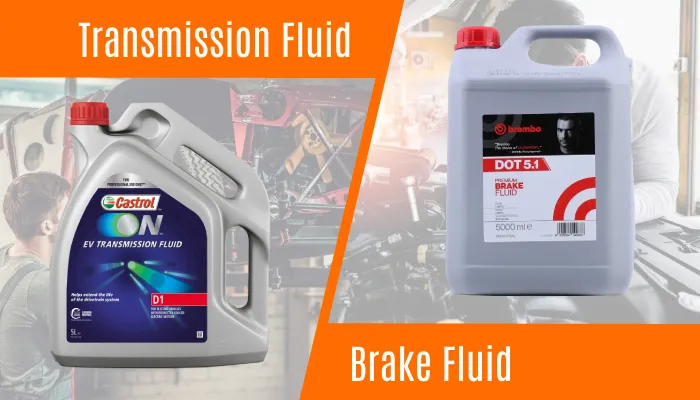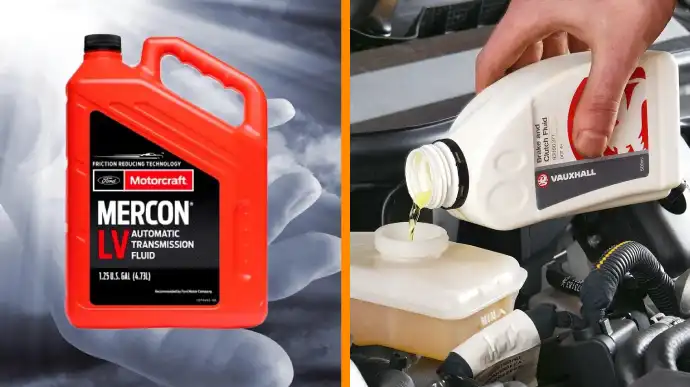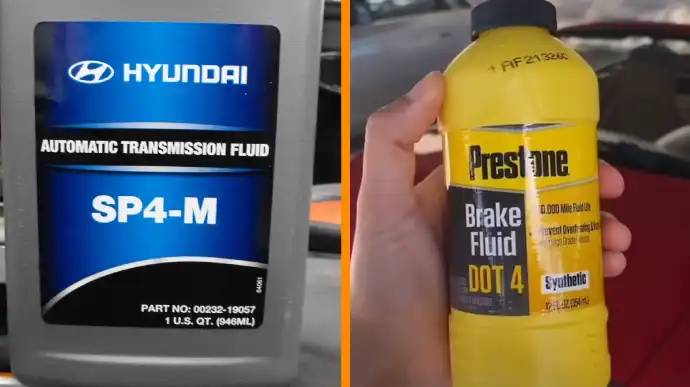Physical Address
304 North Cardinal St.
Dorchester Center, MA 02124

Regarding the fluids that keep your vehicle running smoothly and safely, transmission fluid and brake fluid are two of the most important. While similar in some ways, these fluids have very different functions and properties.
Transmission fluid is typically made of base oils and additives. This fluid lubricates and cools the transmission system to ensure smooth gear shifts and prevent wear and tear.
Conversely, brake fluid is primarily composed of glycol ethers or silicone-based fluids. This fluid transmits force and heat in the braking system, converting mechanical force into stopping power.
In this article, we’ll look closer at the differences between transmission and brake fluid and how to ensure you’re using the right one for your particular vehicle. So keep reading.

There are several key differences between your car’s transmission and brake fluid.
Transmission fluid is primarily designed to lubricate the moving parts of the automatic transmission system. It helps to reduce friction and heat, ensuring smooth gear shifts and preventing wear and tear on the transmission components.
In addition, transmission fluid also aids in cooling the transmission system, which is crucial for maintaining its overall performance and longevity.
In contrast, brake fluid serves a completely different purpose. It’s specifically formulated to transmit brake force from the pedal to the brake calipers or wheel cylinders.
This hydraulic fluid allows the braking system to effectively convert the mechanical force applied by the driver into the stopping power needed to bring the vehicle to a halt.
Transmission fluid is typically made of a base oil, often petroleum-based or synthetic, with additives to enhance lubrication and heat dissipation properties. The base oil provides the necessary lubrication for the transmission components, while the additives help to reduce friction and wear.
On the other hand, brake fluid is a type of hydraulic fluid designed to be non-compressible and resistant to high temperatures. It is usually glycol-based (DOT 3, DOT 4) or silicone-based (DOT 5).
The glycol-based brake fluid contains a mixture of glycols, corrosion inhibitors, and antioxidants, while the silicone-based brake fluid is made of silicones and various additives.
Transmission fluid has a higher viscosity compared to brake fluid. This is because transmission fluid needs to provide lubrication and reduce friction in the transmission components. The high viscosity ensures the fluid adheres to the gears and other moving parts, preventing metal-to-metal contact and wear.
Meanwhile, brake fluid has a low viscosity to facilitate easy flow through the brake lines and actuate the brake components efficiently. The low viscosity allows the brake fluid to exert the necessary force on the brake pads when the brakes are applied, resulting in effective braking performance.
Transmission fluid is typically red or pink, although the color can vary depending on the manufacturer and type. This color is due to the dye added to the fluid to make it easily identifiable.
Conversely, brake fluid is usually clear, light brown, or yellowish. However, brake fluid can darken with age as it absorbs moisture and contaminants.
Transmission fluid is poured directly into the transmission itself, usually located under your vehicle’s hood. On the other hand, brake fluid is poured into the master cylinder, typically found near the engine compartment’s firewall.
Transmission fluid is designed to withstand high operating temperatures, primarily serving a lubrication function. However, it isn’t formulated to handle extreme heat like brake fluid.
Conversely, brake fluid is specifically formulated to withstand the normal to high temperatures generated during the braking process without boiling or compressibility. This is essential for maintaining brake performance and ensuring safe operation of your vehicle.

In transmission fluid, contaminants are usually a result of wear and tear within the transmission itself. This includes metal particles from gears and clutch material that breaks down over time. These contaminants can cause friction and damage to the transmission components, leading to decreased performance and potential failure.
However, brake fluid is highly sensitive to moisture absorption. Moisture can enter the brake system through seals and rubber components, causing corrosion and reducing the effectiveness of the fluid. Contaminated brake fluid can decrease braking performance and can compromise your safety.
Transmission fluid operates under relatively low pressure, typically ranging from 5 to 35 psi (pounds per square inch). This is because transmission fluid’s primary function is lubricating the gears and facilitating smooth gear shifting.
In contrast, brake fluid operates under high hydraulic pressure, typically ranging from 800 to 1,200 psi. High pressure is necessary to transmit force from the brake pedal to the brake components, allowing for efficient stopping power.
Transmission fluid is formulated specifically for the type of transmission (automatic or manual), such as synthetic or mineral, and the make/model of your vehicle. It’s designed to provide the transmission components with lubrication, cooling, and hydraulic pressure.
On the other hand, brake fluid types, such as DOT 3, DOT 4, and DOT 5, are standardized, and it’s crucial to use the type recommended by the vehicle manufacturer. Mixing different brake fluid types can harm the brake system, leading to decreased performance or potential brake failure.
For transmission fluid, the replacement interval can vary depending on the vehicle. Some modern transmissions are sealed for the vehicle’s lifetime, while others require periodic changes. Generally, transmission fluid should be changed every 30,000 to 60,000 miles or every 2 to 4 years.
Alternatively, brake fluid replacement is recommended every 2 to 3 years or as specified in the vehicle’s maintenance schedule. This is crucial to prevent moisture buildup and maintain the integrity of your brake system.
| Characteristic | Transmission Fluid | Brake Fluid |
| Purpose | Lubricate and cool transmission, facilitate smooth gear shifts | Transmit force for braking, enable vehicle to stop |
| Composition | Base oil with additives | Glycol-based (DOT 3, DOT 4) or silicone-based (DOT 5) |
| Viscosity | Relatively high | Low |
| Color | Typically red or pink | Typically clear or slightly yellowish |
| Location | In the transmission system | In the hydraulic brake system |
| System Function | Lubrication, cooling, and gear shifting | Transmits force from brake pedal to brakes |
| Contamination | Contaminated by wear and tear in the transmission | Sensitive to moisture absorption |
| Operating Pressure | 5 to 35 psi | 800 to 1,200 psi |
| Fluid Reservoirs | Stored within the transmission case | Stored in a master cylinder reservoir |
| Fluid Replacement | Replacement interval varies by vehicle, some are sealed | Recommended every 2 to 3 years to prevent moisture buildup |
You should never use transmission fluid as brake fluid. Transmission fluid isn’t compatible with the brake system components and can cause severe damage.
Transmission fluid in the brake system can eat away at the seals of the master cylinder and other system components, leading to leaks and ultimately destroying the entire brake system.
Brake fluid is designed to withstand the high temperatures and pressures generated during braking, ensuring optimal performance and safety. It has a higher boiling point and better lubricating properties than transmission fluid.
It’s recommended to change brake fluid every 30,000 miles or every 2 years, whichever arrives first. This is because brake fluid, over time, can absorb moisture and become contaminated with dirt and debris.
As for transmission fluid, you should change it according to the manufacturer’s recommended intervals. Typically, this is every 30,000 to 60,000 miles, depending on the vehicle and driving conditions.

Using motor oil as a transmission fluid isn’t recommended due to its different properties and functions. Transmission fluid is specifically designed to meet the requirements of hydraulic systems in a vehicle’s transmission. It provides lubrication, cooling, and hydraulic power to the transmission components.
On the other hand, motor oil is formulated to lubricate the engine, reducing friction and protecting against wear and tear. While both fluids serve the purpose of lubrication, they’ve different viscosities, additives, and thermal properties.
Transmission fluid is thicker and has specific frictional properties to ensure smooth gear shifts, whereas motor oil is thinner and designed to withstand higher temperatures and pressures in the engine.
To maintain the optimal performance and longevity of your vehicle’s transmission, regular fluid changes are necessary.
Over time, transmission fluid can become contaminated with debris, dirt, and metal particles, leading to increased friction and wear on the transmission components. Also, the fluid can break down and lose its ability to provide proper lubrication and cooling to the transmission system.
By changing the transmission fluid at the recommended intervals, you can remove the contaminants and ensure that the fluid is clean and can perform its essential functions. Neglecting to change the transmission fluid can result in decreased performance, increased heat buildup, and potential damage to the transmission.
Changing transmission fluid can be expensive due to the specialized equipment and maintenance required for the service. The need for specific tools and equipment mainly drives the cost of this procedure.
To perform a transmission fluid change, you’ll require a lift or jack stand to elevate the vehicle, a drain pan to collect the old fluid, and a fluid pump to refill the transmission with fresh fluid. These items can be quite expensive to purchase and maintain.
Also, specialized knowledge is necessary to properly perform the procedure, which may require the services of a trained technician. All these factors contribute to the overall cost of changing transmission fluid, making it a more expensive maintenance task than other fluid changes.
As you can see, understanding the differences between transmission fluid and brake fluid is essential for maintaining your vehicle’s optimal performance and safety.
By using the right type of fluid and following the recommended replacement intervals, you can ensure your vehicle remains in top condition and your brakes continue to work effectively.
Never use transmission fluid for your brakes unless you’re a fan of disastrous consequences. And don’t forget to change your fluids regularly unless you enjoy the thrill of a breakdown on the side of the road.
So, be sure to consult your vehicle’s owner manual and a trusted mechanic if you have any questions or concerns about your vehicle’s fluids.